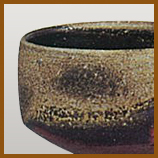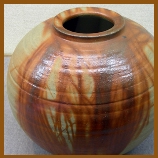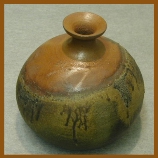- トップ >
- Coloration and Patterns of Bizen ware
Coloration and Patterns of Bizen ware
Goma

“goma” This pattern resembles sesami seeds, produced when Japanese redpine ash adheres to the ware at highest temperatures,
and creats a graze.Ash may also accimulate,melt and drip down the sides. When the gomma drips it is called “tamadare” .
Sangiri

“sangiri” Ash accumulates on the outer edges of kiln and buries the ware placed along the walls. The surface of each piece under the ash, the part not directly exposed to flame, gets smoked and undergoes a chemical change, producing a distinctive gray-blue, gray-black, or black-brown color.
Botamochi

“Botamochi” This pattern is said resemble a sticky riceball covered with sweet red bean paste, called “Botamochi”.
When smaller plates are stacked on larger plates and bowls,the area that are covered recieve no ash, producing round patterns.
Hidasuki

“Hidasuki” Vermilion and red-brown lines or cords by wrapping the piece with softend rice straw. A chemical reaction occurs between the composition of the straw and iron in the cray, resulting in a pattern resembling flames. This technique was originally discovered by accident after wrapping pieces with straw to prevent them from adhering together during firing. Hidasuki has since become a common feature of Bizen ware.
Aobizen(Blue Bizen)

“Aobizen” If a piece is placed in sagger,and the sugger covered with thick layer of embers, a reducing atmosphere is produced. The resulting color becomes a vivid blue-gray, kown as Aobizen, or Blue Bizen. This color is rare, and prized by connnoissereurs. There is also a technique of introducing salt into the kiln during the final stage of firing, which turns the clay into a blue color.
Fuseyaki

“Fuseyaki” This pattern is produced when pieces are intentionally stacked on the top of each other or sideways in order to vary the extent of coverage by ash. Different colors are produced depending on exposure to flame. This technique is often used for sake bottles, flower vaces and pots. The contrast of different colors adds depth and appeal.
